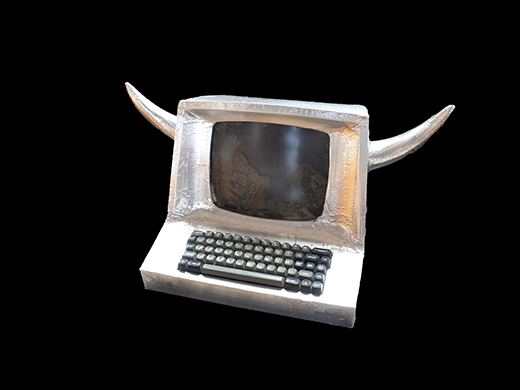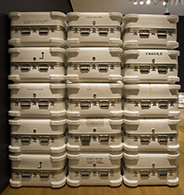Beach Museum of Art exhibition 'FIELD STATION 4' a journey through time, space and beyond
Tuesday, Oct. 29, 2019

"Early Tibetan Computer," from 2016, is part of the "FIELD STATION" works by Charles Lindsay and includes a 1960s working computer, Tibetan yak horns and aerospace aluminum tape. It is on display in the "FIELD STATION 4" exhibition at the Beach Museum of Art. Image courtesy of Charles Lindsay. | Download this photo.
MANHATTAN — Imagine a hybrid field station — a temporary laboratory in a remote location — that seeks to explore deep time, from the geologic to the archeologic and beyond.
Exploration geologist, author and artist-adventurer Charles Lindsay has done just that in the exhibition "FIELD STATION 4," which debuts Nov. 5 and runs through Oct. 3, 2020, at the Marianna Kistler Beach Museum of Art at Kansas State University.
In "FIELD STATION 4," Lindsay delves into earth's geologic and cultural pasts by repurposing scientific equipment salvaged from the aerospace, biotech and military sectors to probe biologic specimens and ancient artifacts, creating immersive environments, sound installations and sculptures.
Lindsay's art springs from his long and varied career.
Before becoming an artist, Lindsay was an exploration geologist in the Canadian arctic, which morphed into a career as a photojournalist. He spent time in ancient cultures, living with a shaman in Tibet and exploring remote places in the Himalayas. He conducted artistic research at the NASA Ames Research Center in Mountain View, California, and eventually landed at the nearby Search for Extraterrestrial Intelligence Institute, known as SETI, where he directs SETI AIR, an artist-in-residence program. The author of eight books of photographs, Lindsay's latest is "Recipes for the Mind," published by Terra Nova/MIT Press.
Lindsay's work at SETI inspired him to create artworks probing the concept of collapsing time, making possible simultaneous encounters with the deep past and acute present. This coalesced in his "FIELD STATIONS" project, an evolving architectural form based on the mineral exploration camps where he worked and in the laboratories at NASA Ames where he made art.
"'FIELD STATION 4' is designed as a place to detach from the outer world, to tune out, or in, to contemplate the nature of information, reality, the other, the future," Lindsay said.
Related to the exhibition will be the event Art and Science in the Anthropocene Age: Public Conversation With Charles Lindsay at 5:30 p.m. Thursday, Feb. 6, 2020, at the Beach Museum of Art. The event is free and the public is welcome.
The Beach Museum of Art, at 14th Street and Anderson Avenue, is open Tuesday, Wednesday and Friday from 10 a.m. to 5 p.m.; Thursday from 10 a.m. to 8 p.m.; and Saturday from 11 a.m. to 4 p.m. Admission is free and free parking is available adjacent to the museum.

